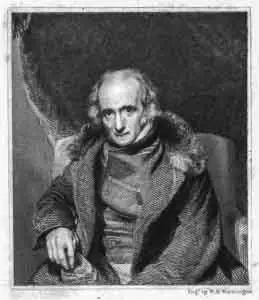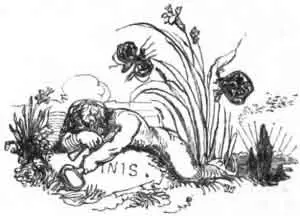Following is the Preface from the James Northcote 1828 book of 100 selected fables. An engraving of Northcote and the end engraving are placed on this page for reference. Also, the Northcote fables are sometimes exact copies of translations found in other sources posted on FablesOfAesop. If that’s the case, only the extra comments made by Northcote and the illustrations are posted here. Finally, the illustrations at the end of many of the fables have nothing to do with the fables they are attached to or to the next fable in order. They are posted here in the order they appear in the book with no attempt to find the right fable they go with.
PREFACE
On the life of Aesop, as invented by Planudes, the Greek monk, La Motte well remarks, that it was a happy thought to make Aesop a slave, and his master a philosopher. The slave was to manage his master’s pride, he dared not speak to him certain home truths; and there was no better way to join sincerity with prudence and respect, than by Apologue and Fable. On the other hand, his master would not have acted like a wise man, had he looked no further than the surface. His part was to extract instruction from fictions, in which it was so ingeniously covered. He was to be pleased with the considerate artifice of Aesop and to forgive him the lesson, for the sake of his address and courtesy.
By this may plainly be seen what the author of Fables and his readers are in relation to each other. The Fabulists are the slaves, who are willing to instruct them without hurting their pride. The readers are the masters, who willingly admit the truth, since it is partly left to themselves to have the honour of finding it out.
It may be expected that I should say something respecting my motives for the present undertaking. I have only to observe, that a chief inducement in making this collection, was the amusement and employment it afforded me in the way of my profession as a Painter, in sketching designs for each Fable. I am therefore the less anxious about what may be said by Critics on the literary part of the work. They will quickly perceive it has been gathered from various sources: the greater portion of the Fables are of my own invention; others are drawn from well known subjects.
In a word, I do not desire greater indulgence for my faults than I dare hope from candour, and the gratification I may possibly have the good fortune to afford.
In the numerous embellishments of this volume, I claim but a part of the merit it may by chance possess. Although the original invention and designs for the prints at the head of each Fable are my own, yet they have been most excellently drawn on wood, and prepared for the Engravers, by Mr. William Harvey, one of the most distinguished artists in his profession; and many of them have been improved by his skill.
The ornamental letter at the beginning of each Fable, and the vignette at the end, are solely the invention of Mr. Harvey.
The execution of the prints has been intrusted to the hands of the most eminent engravers in England in this department, who have earned their due share of praise, by the ability with which they have acquitted themselves; and the Critic in art is referred to the Index for the names of each individual, whose merits he would ascertain.
Also much is due to Mr. John Johnson, of the Apollo Press, whose skill in the difficult task of printing engravings on wood, has been long well-known and firmly established.
J. N.
8, Argyle Place,
Jan. 1, 1828.

